How To Repair Rips In Mobile Home Return Air Ducts

Mobile Home Energy
Step five: Duct Sealing Techniques
This is the page opening:
![]() Duct sealing is easy for the mobile dwelling house do-it-yourselfer to handle
Duct sealing is easy for the mobile dwelling house do-it-yourselfer to handle
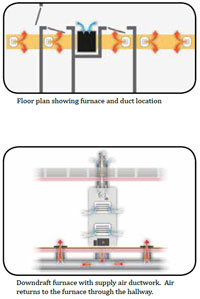 Once you lot commit to improving the energy performance of your mobile home, fixing upwardly the ductwork becomes 1 of the first priorities. In nigh all cases, the ducts were poorly made at the mill with lots of leaks at the joints. Moving the abode to the site location loosens those joints and normal vibration also contributes to leakage. Fortunately, sealing the leaks is relatively easy, quite inexpensive and pays big dividends.
Once you lot commit to improving the energy performance of your mobile home, fixing upwardly the ductwork becomes 1 of the first priorities. In nigh all cases, the ducts were poorly made at the mill with lots of leaks at the joints. Moving the abode to the site location loosens those joints and normal vibration also contributes to leakage. Fortunately, sealing the leaks is relatively easy, quite inexpensive and pays big dividends.
Newer manufactured homes are more efficient than the mobile homes congenital in the 1960's and 1970's. Furnaces are also ameliorate, with sealed combustion at present standard. The duct systems however take not evolved. Down draft furnaces, coupled to nether-floor trunk lines and risers is still the standard installation method and the workmanship is often junior. The techniques for duct sealing described below are relevant even in newer manufactured homes. Sealing the ductwork may reduce heating bills by fifteen-17%.
Most mobile homes have a chief trunk line (duct) that runs down the middle of the structure, just nether the floor. Each room has at least one supply annals. Most oftentimes, the air that returns from the room to the furnace merely flows out the doorway and down the hall to the grills on the furnace. These systems are called "Open Render" systems.
When the supply ducts leak, that warmed up, expensive air is pushed into the belly and lost to the outside surroundings. Yous lose equally much every bit 32% of the heat produced in the furnace through these leaks. That's expensive and means that your furnace is working overtime, trying to heat the house. Leaky supply ducts also result in negative pressure level within the house as the furnace takes indoor air and sends it outside. Cold, outside air is pulled into the home because of this pressure imbalance.
In a few homes, in that location are additional registers along the outside walls of each room, and a large, screened pigsty in the floor side by side to the furnace. In this type of duct system, the cooler, returning air is pulled back to the furnace through the outside wall floor registers, downward the floor joist cavity and then uses the belly wrap as the return plenum. This is a "Ducted Cold Air Return" system. Ofttimes, it is extremely leaky.
If your domicile has return air ducts, and they are leaky, your house volition have positive pressure, forcing warm, moist air from inside the house out through leaks in the walls and roof. Over time, this can rot out the framing, not an uncommon occurrence in older homes. These duct systems ordinarily have huge leaks and should be converted to an Open Render organisation.
![]() Converting to an Open Return organization is a project you can exercise yourself. Showtime, the return registers, which are commonly located along the outside walls, are removed. The holes in the flooring are plugged with plywood, caulked and the large pigsty next to the furnace is likewise permanently sealed.
Converting to an Open Return organization is a project you can exercise yourself. Showtime, the return registers, which are commonly located along the outside walls, are removed. The holes in the flooring are plugged with plywood, caulked and the large pigsty next to the furnace is likewise permanently sealed.
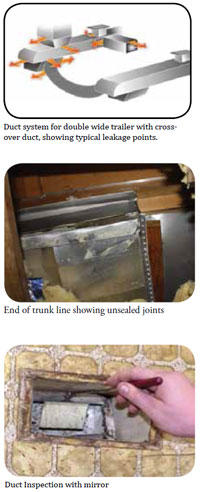 Make sure that a sufficiently large pathway to the hallway is available. A furnace technician tin cheque to encounter if there is less than a 3 Pascal pressure level difference between the room and the hallway when the furnace fan is running. If non, and then interior doors will need to be undercut to allow air motion or grills placed in the wall. If the furnace is in a closet with a door, the door must have grills top and bottom to let the heated air to return to the furnace. In general, the size of these openings corresponds to the opening size of the supply registers.
Make sure that a sufficiently large pathway to the hallway is available. A furnace technician tin cheque to encounter if there is less than a 3 Pascal pressure level difference between the room and the hallway when the furnace fan is running. If non, and then interior doors will need to be undercut to allow air motion or grills placed in the wall. If the furnace is in a closet with a door, the door must have grills top and bottom to let the heated air to return to the furnace. In general, the size of these openings corresponds to the opening size of the supply registers.
Sealing the Ductwork
Understanding how the duct arrangement is laid out and how the parts are connected together is a big help in identifying hidden leaks. Joints betwixt sections of the duct system are the near common location of leaks.
Showtime, if you are having a blower door test on your domicile, have the operator exercise a pressure pan test on all ducts while the blower door is operating. High pressure readings indicate large leaks. If they are over 1 Pascal, then they need to exist sealed. Although we recommend that all annals boots get sealed, information technology does make sense to locate the biggest leaks in the duct system. The furnace to principal trunk connection is often the worst problem area. In homes with supply registers on the outside walls, the main trunk to lateral connexion is especially difficult to access. Step 2 is to visually inspect the interiors of the ducts with a flashlight and mirror. Remove the register encompass and then lay a flashlight down in the duct facing i direction. Using a mirror, advisedly inspect all surfaces of the ductwork. You volition likewise exist able to observe and remove any obstructions that accept fallen within the ductwork from the register openings. Visual inspection is also useful to check on your sealing coverage.
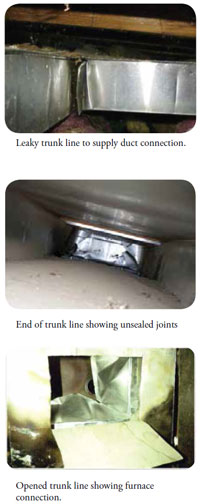 Sometimes the ductwork is exposed under the trailer if the belly wrap is damaged. In this case, sealing up the ductwork might be easier from below, working on the exterior of the duct.
Sometimes the ductwork is exposed under the trailer if the belly wrap is damaged. In this case, sealing up the ductwork might be easier from below, working on the exterior of the duct.
The goal is to seal all leaks and open joints in the ductwork, and to seal the register boot to the wood floor. To seal the duct from above at the floor register, follow this procedure:
Audit the interior of the duct and remove all objects that have fallen into the duct. Scrape and vacuum out the duct, then scrub it downwardly thoroughly with rubbing alcohol and a rag. Use a good respirator when using the alcohol. Washing downwards the dirty metallic insures that the sealing materials will adhere to the duct.
When the metal is clean and dry out, tape all seams and joints with canonical foil faced butyl tape. Do not utilise "duct record" which is an inferior product and will fail over time. Tape all sides of the kick up and over the edge of the subfloor. Staple that record to the subfloor. Then, use approved mastic to coat all seams and edges of the record. Allow the mastic dry and supercede the annals cover. If the register has movable dampers, remove them with a plier or replace the annals with an open comprehend.
1 particularly leaky spot is at the end of the trunk line on both ends of the mobile home. To seal this off, coil upwardly a 12 inch length of fiberglass batt and place in a kitchen sized garbage bag. Stuff this "poly bag" down the register boot and into the principal trunk line just past the boot. Then utilize your butyl tape to create an airtight bulwark. Coat this new duct bulwark with mastic.
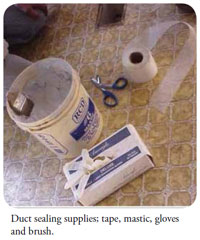 If the pressure pan indicates that the furnace to trunk line joint is leaky, and so sealing is in social club. On a few furnaces, this joint is accessible from higher up. Often, the only way to access this joint is to cutting a hole in the abdomen wrap and so cut open up the bottom of the main duct directly below the furnace. Once exposed, you can fold back whatever loose ends of duct metal, tape the joints and apply mastic. Then shut up the bottom of the trunk, screw on a metal patch, and seal as above. Finally, close up the belly wrap. This procedure is more of a hassle, but essential. If your home has flexible crossovers or joist pan crossovers, a like approach may exist necessary.
If the pressure pan indicates that the furnace to trunk line joint is leaky, and so sealing is in social club. On a few furnaces, this joint is accessible from higher up. Often, the only way to access this joint is to cutting a hole in the abdomen wrap and so cut open up the bottom of the main duct directly below the furnace. Once exposed, you can fold back whatever loose ends of duct metal, tape the joints and apply mastic. Then shut up the bottom of the trunk, screw on a metal patch, and seal as above. Finally, close up the belly wrap. This procedure is more of a hassle, but essential. If your home has flexible crossovers or joist pan crossovers, a like approach may exist necessary.
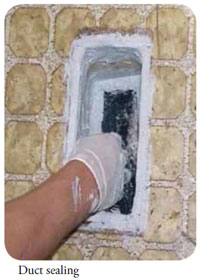 Once all the duct piece of work is sealed upwardly, check for force per unit area loss with the pressure pan while running the furnace fan. If the readings are within limits, then y'all can proceed to repair the rest of the belly wrap and accept your floor insulated. Before yous are totally finished make sure that bathroom and sleeping room doors are undercut and so that those rooms don't over pressurize.
Once all the duct piece of work is sealed upwardly, check for force per unit area loss with the pressure pan while running the furnace fan. If the readings are within limits, then y'all can proceed to repair the rest of the belly wrap and accept your floor insulated. Before yous are totally finished make sure that bathroom and sleeping room doors are undercut and so that those rooms don't over pressurize.
Congratulations! You've completed a dirty, but essential first step in improving your home. Now, all that expensive oestrus you lot are paying for is heating your domicile instead of the neat outdoors. You'll discover immediate comeback in your comfort and too accept lower utility bills.
An excellent demonstration that shows how to seal ductwork tin can exist seen at http://wxtvonline.org/2010/06/ductsealing/
How To Repair Rips In Mobile Home Return Air Ducts,
Source: https://www.e3a4u.info/energy-technologies/mobile-home-energy/step-5-duct-sealing-techniques/
Posted by: andersonbligh1975.blogspot.com


0 Response to "How To Repair Rips In Mobile Home Return Air Ducts"
Post a Comment